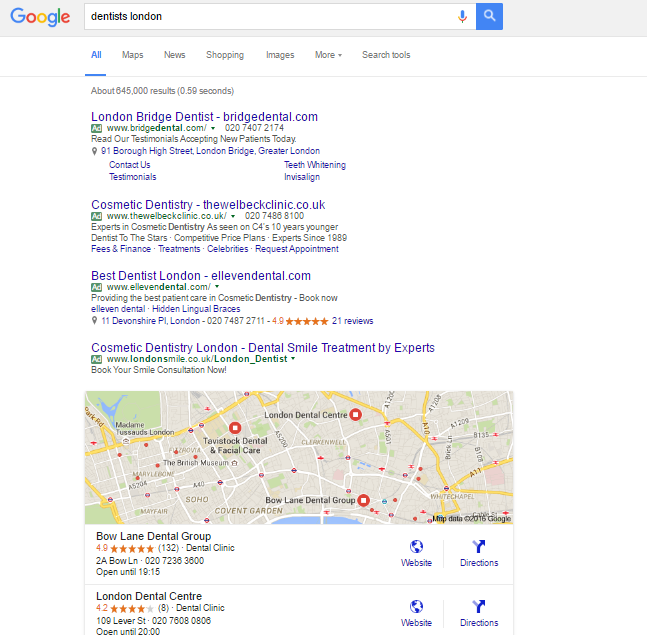SEO Strategy in an Increasingly PPC Dominated World
The layout of Google’s SERPs (search engine results pages) has changed dramatically over the years. With maps, videos, images, featured snippets, the Knowledge graph, news and various personal suggestions all claiming their place, the first page of Google’s SERPs is now almost unrecognisable.
As marketers, one of the biggest shakeups we’ve seen this year is the increasing real estate given to paid search.
In February of 2016, Google announced (after years of testing) that paid search ads will no longer appear on the right hand side of the SERPs and that for ‘highly commercial’ terms, they’ll show an additional ad at the top, thereby increasing the space given to paid advertising from three places to four.
Paid search ads that didn’t make the top four places were moved to the bottom of the page. This meant that for some ‘highly commercial’ queries, you could see no less than seven paid search ads, which severely limited the number of organic possibilities.
The reasoning behind this shift was fairly sound and understandable. With the explosion of mobile usage and the corresponding local signals, Google wanted to standardise the listings across devices.
For many brick-and-mortar businesses, this meant a renewed interest and push for better local listings. The reward for appearing in the local three-pack was never more attractive. With the local listings appearing just beneath the top paid ads and above the normal organic ones. In essence, jumping into first place for anything organic.
More recently, and somewhat more controversially, Google has started to offer paid listings in the local finder as well, reached after clicking “More places” from a local three-pack in the main Google search results.
This is yet another piece of prime real estate that has been sold to advertisers.
What does this mean for organic listings?
Before answering this question, it’s important to understand the reasoning behind these changes.
Search engines and Google, in particular, have become increasingly good at understanding user intent. If I’m searching to buy a laptop and search the exact laptop model with the words ‘buy’ or ‘purchase,’ Google knows and understands this intention, and being a strictly commercial one, they’d most likely present me with a series of paid search ads.
Is this a bad user experience? The answer, in most cases, is no. I’m looking to buy a laptop, I know what kind of laptop I want to buy and at this stage in my decision making process I just want to be presented with options of where to buy it. My intent is purely commercial and transactional. Displaying a series of paid ads is more relevant to me and provides better performance for advertisers. In many ways, a win-win situation.
It’s the informational ‘Micro-moments’ that SEO strategy should be attempting to target. The billions of queries that are not highly commercial and offer some scope for branding and connection.
There are over 3.5 billion searches on Google a day. Over 15% of these search queries have never been seen before.
Google’s engineers now feel confident enough in RankBrain’s ability to sift through these unrecognised queries (sorting them into vectors and assigning a ‘probable’ meaning to them) that they’ve recently announced RankBrain is now used in every search. It has become the third most important ranking signal (after links and content).
As we mentioned in our article about semantic search, we’re moving away from strings to things. Towards meaning and providing true value to the user.
A combined PPC and SEO search strategy
Having a combined SEO and paid search strategy is a good way forward for many companies. Particularly for e-commerce sites.
You’d have a carefully targeted PPC campaign with different landing pages for the commercial ‘I-want-to-buy-now,’ moments and a strong organic presence for people at the informational and research stages. Rather than competing with each other, these different listings would compliment one another, reinforcing your brand and presence at every stage of the decision making process.
The path to purchase is fragmented and non-linear. More so now than ever before.
The consumer journey has been fractured into hundreds of tiny decision-making moments at every stage of the ‘buyer’s funnel’—from inspiration to purchase.
For SEO to succeed, we need to address these ‘Micro-moments.’ We need to answer people’s questions, exceed their expectations and meet them at whatever stage of the decision making process they are currently in.
As a recent study by Google concluded – you need to be there, be useful and be quick. Therein lies the key to success online.



